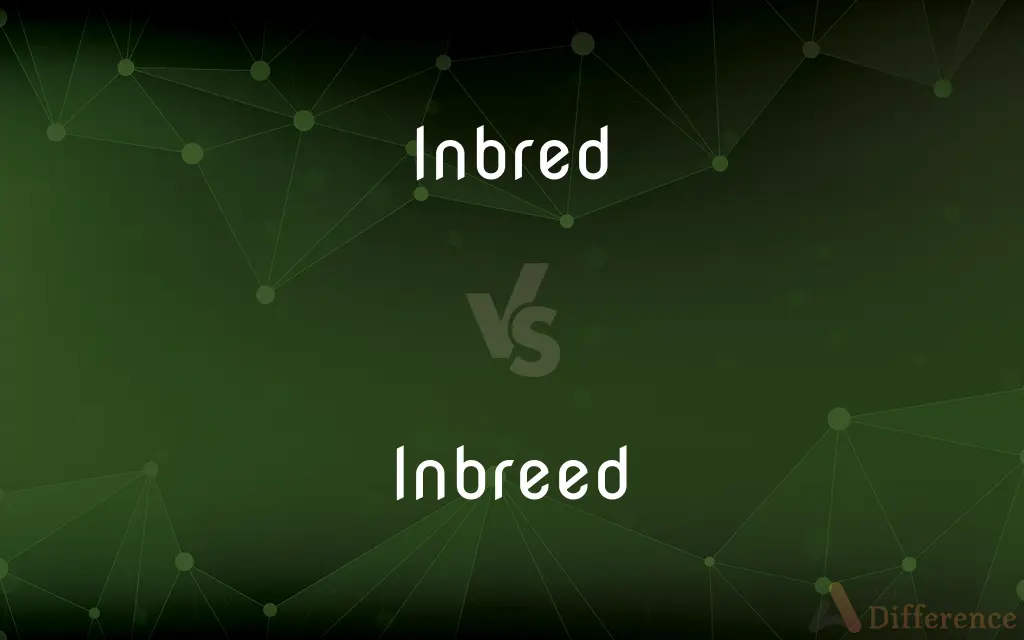Inbred vs. Inbreed — What's the Difference?
By Fiza Rafique & Urooj Arif — Updated on April 8, 2024
Inbred is an adjective describing organisms produced by inbreeding, while inbreed is a verb meaning to produce offspring through the mating of closely related individuals.

Difference Between Inbred and Inbreed
Table of Contents
ADVERTISEMENT
Key Differences
Inbred refers to the characteristic or state of being produced as a result of inbreeding, which is the practice of mating organisms, especially animals and plants, that are closely related genetically. Inbreed, on the other hand, is the action of engaging in inbreeding. It involves deliberately mating individuals that are closely related to each other to preserve desirable traits within a lineage, a common practice in selective breeding programs in agriculture, horticulture, and animal husbandry.
While inbred focuses on the result of the action, inbreed describes the process itself. Inbreeding can be a controlled breeding strategy to stabilize desirable traits in a population, but it requires careful management to avoid detrimental effects associated with increased homozygosity, which inbred individuals often exhibit.
The distinction between inbred and inbreed is crucial for understanding discussions in genetics, breeding, and conservation biology. It underscores the importance of genetic diversity and the potential risks and benefits of breeding strategies employed in various contexts, from agriculture to conservation of endangered species.
Comparison Chart
Definition
Describes organisms produced by inbreeding.
The act of producing offspring through closely related individuals.
Focus
Resulting characteristic or state of being.
The process or action of mating.
ADVERTISEMENT
Common Usage
Used to describe offspring with closely related parents.
Used to describe the action taken to mate closely related individuals.
Consequences
Can lead to genetic disorders and reduced diversity.
Aims to preserve desirable traits but risks genetic health.
Field of Application
Genetics, breeding programs, conservation biology.
Selective breeding, agriculture, animal husbandry.
Compare with Definitions
Inbred
Used in conservation to describe endangered species risks.
The inbred wolf pack faced increased health problems.
Inbreed
Requires management to mitigate health risks.
To inbreed responsibly, breeders monitor genetic health closely.
Inbred
Can refer to isolated populations with limited gene flow.
The inbred island community had a unique genetic marker.
Inbreed
Can lead to a homogeneous genetic population.
Inbreeding in the captive population aimed to preserve rare genes.
Inbred
Resulting from the mating of closely related individuals.
The inbred population of lions showed decreased fertility.
Inbreed
In conservation, it may be used to save species from extinction.
Scientists sometimes inbreed endangered species in controlled programs.
Inbred
Characterized by reduced genetic diversity.
Inbred plants in the greenhouse were more susceptible to disease.
Inbreed
To mate individuals with close genetic relationships.
Breeders inbreed flowers to enhance specific characteristics.
Inbred
Often associated with negative genetic consequences.
Inbred dogs may have a higher risk of hereditary health issues.
Inbreed
A practice in selective breeding to stabilize traits.
Farmers inbreed chickens for faster growth rates.
Inbred
Produced by inbreeding.
Inbreed
To subject to inbreeding.
Inbred
Consisting of or involving a homogenous or unvaried group of people
"[The college's] faculty became markedly less inbred, with the proportion of alumni dropping from 68 to 41 percent" (Jerome Karabel).
Inbreed
To engage in inbreeding.
Inbred
Fixed in the character or disposition as if inherited; deep-seated
An inbred distrust of radicalism.
Inbreed
To breed or reproduce with those that are related.
Inbred
Bred within; innate.
Inbreed
To breed with those that share common traits or qualities.
Inbred
Having an ancestry characterized by inbreeding.
Inbreed
To produce or generate within.
Inbred
(genetics) Describing a strain produced through successive generations of inbreeding resulting in a population of genetically identical individuals which are homozygous at all genetic loci.
Inbreed
To produce or generate within.
To inbreed and cherish . . . the seeds of virtue.
Inbred
Simple past tense and past participle of inbreed
Inbred
(vulgar) An inbred individual.
Since you all marry your cousins I bet you're a bunch of inbreds.
Inbred
Bred within; innate; as, inbred worth.
Inbred
Produced by inbreeding
Inbred
Normally existing at birth;
Mankind's connatural sense of the good
Common Curiosities
Can inbreeding be beneficial?
Inbreeding can be beneficial for reinforcing specific desirable traits, but it requires careful management to prevent detrimental health effects.
What does inbred mean?
Inbred refers to an individual or group resulting from the mating of closely related organisms, often highlighting genetic homogeneity and associated risks.
What is the purpose of inbreeding?
The purpose of inbreeding is to preserve and stabilize desirable traits within a population, though it must be managed to avoid negative genetic outcomes.
How does inbreeding affect genetic diversity?
Inbreeding reduces genetic diversity, making populations more uniform but potentially more vulnerable to diseases and genetic disorders.
What are the risks of being inbred?
The risks include an increased likelihood of inheriting genetic defects, reduced fertility, and a higher susceptibility to diseases.
What's the difference between inbred and purebred?
Inbred refers to offspring from closely related parents, while purebred refers to animals of a recognized breed with a documented pedigree.
Why do conservationists sometimes inbreed species?
Conservationists may inbreed species to preserve genetic traits critical for the survival of endangered populations, though it's typically a last resort.
Can inbreeding be reversed?
The negative effects of inbreeding can be mitigated by introducing unrelated individuals into the breeding pool to increase genetic diversity.
How is inbreeding controlled in breeding programs?
In breeding programs, inbreeding is controlled through careful selection and monitoring of genetic health to minimize adverse effects.
What measures can mitigate the risks of inbreeding?
Regular health screenings and genetic testing are essential measures to mitigate the risks associated with inbreeding in captive populations.
Share Your Discovery

Previous Comparison
Obese vs. Pudgy
Next Comparison
Homozygous vs. HeterozygousAuthor Spotlight
Written by
Fiza RafiqueFiza Rafique is a skilled content writer at AskDifference.com, where she meticulously refines and enhances written pieces. Drawing from her vast editorial expertise, Fiza ensures clarity, accuracy, and precision in every article. Passionate about language, she continually seeks to elevate the quality of content for readers worldwide.
Co-written by
Urooj ArifUrooj is a skilled content writer at Ask Difference, known for her exceptional ability to simplify complex topics into engaging and informative content. With a passion for research and a flair for clear, concise writing, she consistently delivers articles that resonate with our diverse audience.















































